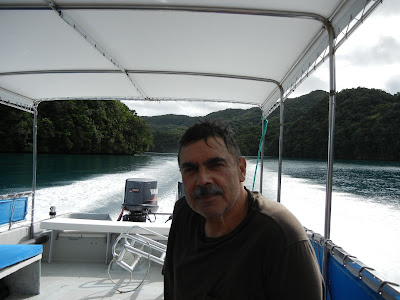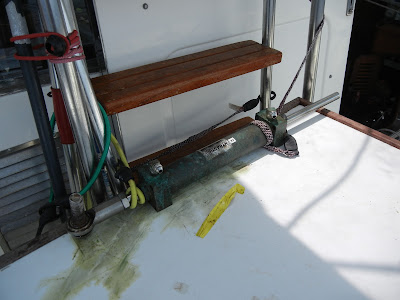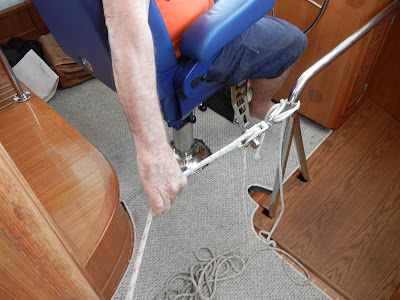We stayed a couple of extra days in Koror to give David a chance to see something of Palau before we took off. It is truly a beautiful place.
We hired one of Neco Marine's boats to cruise around the Rock Islands, doing a bit of snorkeling. David is an active scuba diver that has seen a lot of places. I think he'd tell you that this is one of the best.
One of the sights I took David to see was the Republic of Palau Capitol building.

These buildings, as you can see, are truly splendid. They are not quite as big as their US counterparts but close. Paradoxically, these buildings are nearly deserted most of the time because they are located many miles from any sizeable population center. You have to really want to go here.
There is a delicious irony here that we both appreciated. The total population of the Republic of Palau is only 20,000 people. I used to live in a small town in Wyoming about the same size. Its as if the city government of Rock Springs housed themselves in such an edifice, but located it in the sagebrush desert 30 miles North of town. It would probably have caused the same furor in Palau as it would have in Wyoming, but the Palauans didn't have to pay for it. This wonderment was paid for primarily by US taxpayers!! You may remember that these Islands were part of a US Protectorate after WWII. When the US wanted to stop "protecting" them, leaving them as an independent country, this was part of the cost of disengagement.
We topped off our tanks, cleared out of the port and got underway by noon on the 9th of September. The trip between Palau and Surigao Strait in the Phillippines was uneventful in reasonably calm seas. We got there on the 13th. Some of you may note that this is not the shortest route across the Phillippines. We could have saved quite a few miles if we'd stayed South of Mindanao. The problem with that is that we'd have had to pass through the Sulu Archipelago, an area our insurance company identified as having high piracy risk and wouldn't cover us there.
The Bohol Sea, also known as Leyte Gulf of WWII fame, was a bit rough for most of the day it took to cross it. We entered the Sulu Sea from the East late on the afternoon of the 14th of September and conditions began to improve considerably.
By the afternoon of the 15th, it was a beautiful calm day. . .fortunately.
In the middle of this otherwise lovely day, we got a "steering response failure" alarm from the autopilot. When we put the autopilot in standby and tried to steer manually, nothing happened. Those of you familiar with Arcadia I know that almost everthing needed for safe passage has redundancy. For steering, there are two autopilots, each with their own pumps, plus the manual wheel. Unfotunately, all three of these devices only pump oil to the one steering ram that's attached to the rudder. This one ram, was held together by 4 threaded stainless steel rods. Note in the picture below that there are no such rods on the ram. All of them had broken at the thread roots where they screwed into the gimbal end, rendering all hydraulic steering mechanisms inoperative!
Not to be daunted, David jumped down into the lazarette and removed the offending ram. It was quickly apparent that we couldn't repair it aboard. Together we dragged out the emergency tiller and, within a few minutes, came up with an elegant steering system using some bungee cords and the storm staysail sheet tackle.

We could actually steer from the wheelhouse, sitting in the helm chair, no less.
As we entered the bay at Puerto Princesa in the early evening of the 16th, we saw a likely anchorage among some local fishing boats,.dropped the hook and went to bed early.
The next morning we rigged down the dinghy and Dave took me ashore with the steering ram and ship's documents. I caught a trike taxi and set out first to clear into the port.
While I was looking for the Port Captain's office, I found myself at the gatehouse of the local Phillippine Coast Guard station. When I explained our situation, the duty team decided that I was a vessel in distress and took it upon themselves to get me back to seaworthy condition. They assigned a seaman to take me to a good machine shop on his motorcycle. The shop had 4 new stainless rods threaded in the time it took me to get a haircut and buy some hydraulic oil. The seaman then loaded me up and set out to take me back to the boat. That turned out be be a bit of a project. I knew what the place we were anchored looked like from seaward, but not the name of it, of course. My description must have sounded like another place he knew, so he took me there but Arcadia I was nowhere to be seen. I had a handheld VHS, but that only resulted in a classic "who's on first" routine between David and me. By the time we figured out where we had to go, it was raining cats and dogs. When the whole comedy was over, the day was shot. Nonetheless, we installed the repaired ram, filled and vented the system and were seaworthy again before we went to bed.
There's an embarrassing sequel to the steering event. After we got to Singapore, and were cleaning the boat for Bruce Harris' arrival, we discovered, under the spare paravanes. . .you guessed it. There was a brand new, complete and beautifully preserved spare steering ram that I didn't know, or had forgotten was there. The first owner of the boat, Dave Chambers, had done a great job of assuring redundancy. Oh, well. It made an adventure out of an otherwise relatively uneventful trip. I think we enjoyed Palawan more than we would have Borneo, anyway.
The next morning, Saturday, we moved Arcadia I farther into the bay to the Abanico Yacht Club that the coast guard said was there. We received an extraordinarily warm welcome and were invited to join them in their weekly, sumptuous, buffet. they also had a good internet connection. That afternoon we went sightseeing in Puerto Princesa. I'd been here before, on Mandy, but hadn't actually gone ashore. This time, we hailed the first trike, that came along and just pointed forward to see what we might.
Trikes are the Phillippine equivalent to the tuk-tuks of Indonesia and Thailand. They are a fanciful combination of a 100cc motorcycle married to a big sidecar. They are everywhere. You just hail the first empty one that comes along for cheap transportation to wherever you want to go.
Palawan is a delightful place! There was pork in every restaurant, lots of churches and we saw no mosques. As Americans, we were probably safer here than many places in California. While we were out, we met a trike driver we could communicate with, so we hired him as our guide for the next day. We asked him to book a van to take us across the island.
The next morning, we got in the van, and set out. Great scenery on winding, but generally good, roads.
We stopped to take a tour of the "Underground River". Pretty impressive. There were a lot of other tourists, but the whole thing was managed well enough that it felt like a personalized tour. The underground cavern was, indeed, impressive.
We somewhat reluctantly left Puerto Princesa early on September 20th. Seas were lively enough that we set the paravanes in the water. Weather Bob was watching the storm that later became the first of three typhoons to hit Luzon. He advised that it was tracking too far North to have any significant impact on our passage onward to Singapore. Since we were then almost 10º North lattitude and Singapore is at 1º15' North our exposure to tropical storms would diminish rapidly as we travelled.. We passed from the Sulu Sea into the South China Sea at Cape Melville on September 21st. Bob indicated that the tropical storm was intensifying but would remain too far North to be of concern. He did warn us that the South China Sea weather was unsettled enough that we could expect some local squalls.
Weather Bob's prediction proved to be all too true. The squalls were, indeed, localized. None lasted more than an hour or so. However, there was rarely more than a few hours between them. Many of these squalls were pretty violent, with heavy rain and winds up to 65 knots. Because of the breaks between them, the seas never got organized or built to any great height. Nonetheless, the ride was pretty miserable from Cape Melville until just before we got to Singapore.
We timed our arrival at Horsburgh Lighthouse, on the East end of Singapore Strait, for first light on September 28th. This is the start of the vessel separation scheme that is sort of a super beltway for large ships coming and going from Singapore. Vessels less than 20 meters in length, like us, have no rights within it. Thus, we needed to cross over to the North side of the separation scheme to get into the normal fairway where other vessels weren't specifically empowered to run us down. For an 8 knot boat, this is a hair rasing experience. There were literally dozens of ships in each lane. All travelling at about 16 knots, with only a small space between them. It took us more than an hour to find an opening wide enough to make it across the Westbound lanes and another hour to find another to get the rest of the way across!
Once on the inside of the traffic separation scheme, the number of ships coming, going, or at anchor is unbelievable. The Ch 16 radio traffic is completely undsciplined and non stop. We finally shut off the AIS because it was a huge distraction, providing almost no useful information. Apparently no one bothers to shift their AIS to report "at anchor", so we couldn't filter the anchored ships from the real threats.
As you can see, radar has the same problem.
Daunting as it was, I wouldn't have missed the opportunity to circle around Singapore. It is truly the crossroads for the world's shipping traffic. We didn't actually count the number of ships we saw, underway, docked and at anchor, but it was thousands. I'll never be intimidated by Long Beach/LA again.
We finally wound our way into the Johor Strait and got to Raffles Marina at 3:45 PM. We had called ahead to the marina on VHF 77, and a Customs & Immigration guy met us in the marina office at 4:00 PM and we were cleared in by 4:30 PM. You gotta love Singapore for efficiency.
We spent the next couple of days resting up, and playing tourist around Singapore. It was David's first time in this truly fascinating city. It's not like any other place that I know. If you expect to see much of the old, exotic SE Asia, you'll be disappointed. It's a very modern, landscaped and manicured city. Public trnsportation works like no where else in the world that I've been. There are no slums, just an overwhelming number of high rise apartment buildings. The business districts are showcases for high rise architecture that boggle the mind. Having said all that, neither Dave nor I took any pictures of the city. You'll just have to google it to see.
Between sightseeing trips, we undertook to clean up the boat. I hired a great crew of 4 boat boys to do the outside, while David and I put the inside in order. David left for home after 3 days and I got out the dustrags, vacuum cleaner and carpet scrubber to get Arcadia I ready to meet the buyer.
On the 6th his surveyor arrived, a great husband and wife team, just in time to help me move her onto the slings for a quick haulout. The hull was in excellent condition, with only a pressure wash needed to get rid of the little bit of slime on the botom and moss at the waterline. The buyer was concerned about osmosis and hull blisters, so the surveyor tapped about with vigor, finding nothing. We changed the zincs on the bow thruster and were back in the water within an hour. After a short sea trial, we tied back up to our slip.
The next day, the surveyors looked into everything and asked a lot of questions. I thought they were remarkably thorough. While they seemed to miss nothing, they also made it clear that they understood that we'd just completed a long passage and they had expected to find even more issues than they did.
The following day Bruce Harris arrived. I gave him a quick tour of the boat, then left him with the surveyors to be debriefed by them. I came back after a couple of hours. Bruce stood up and said "the surveyors love your boat, we've got a deal". We shook hands and the deal was done. Jeff Merrill, PAE's brokerage agent from Dana Point, flew to Singapore to participate in the final negotiations. He arrived a couple of hours later, in time to buy dinner.
The next day, Monday, October 9th, Jeff and I had a great time taking Bruce on a familiarization cruise in Johor Straits. He was a quick study on boat handling, but was drinking from a fire hose when it came to learning the various systems aboard. Bruce had to leave that evening, but Jeff and I had both booked our returned flights on Wednesday. We spent our time writing operating procedures for Bruce when he came back to take Arcadia I to her new home.
Epilogue
So, he bittersweet moment that we've always known must come has arrived. This passage, from Palau to Singapore, will be the last one I''ll take aboard Arcadia I, at least the last one as her owner. We've treasured the opportunity to share our experience aboard with so many good friends and our family.
We've all loved this stout little ship that carried us in such comfort and safety on so many adventures. We know that she is ready to carry her new owner, Bruce Harris, on many more. We hope he enjoys her as much as we did.
After we left Singapore, the transaction completed without a hitch. Before the end of October Bruce and his crew arrived in Singapore for the passage to Arcadia I's new home port. They reportedly had a fine passage and look none the worse for wear after they got there. That's Bruce on the right.
Here she is in her new home port, Langkawi, Malaysia.
Finis.
















